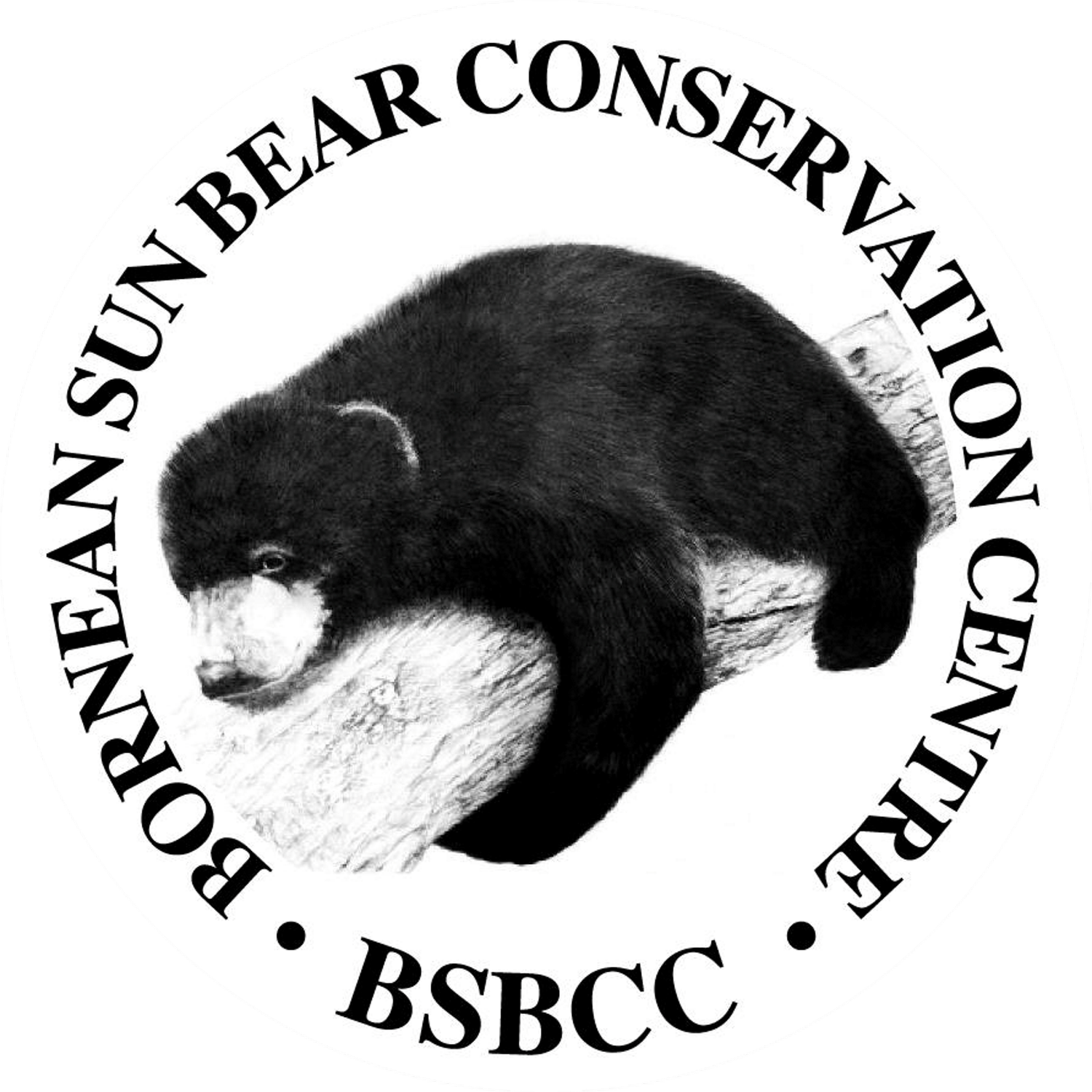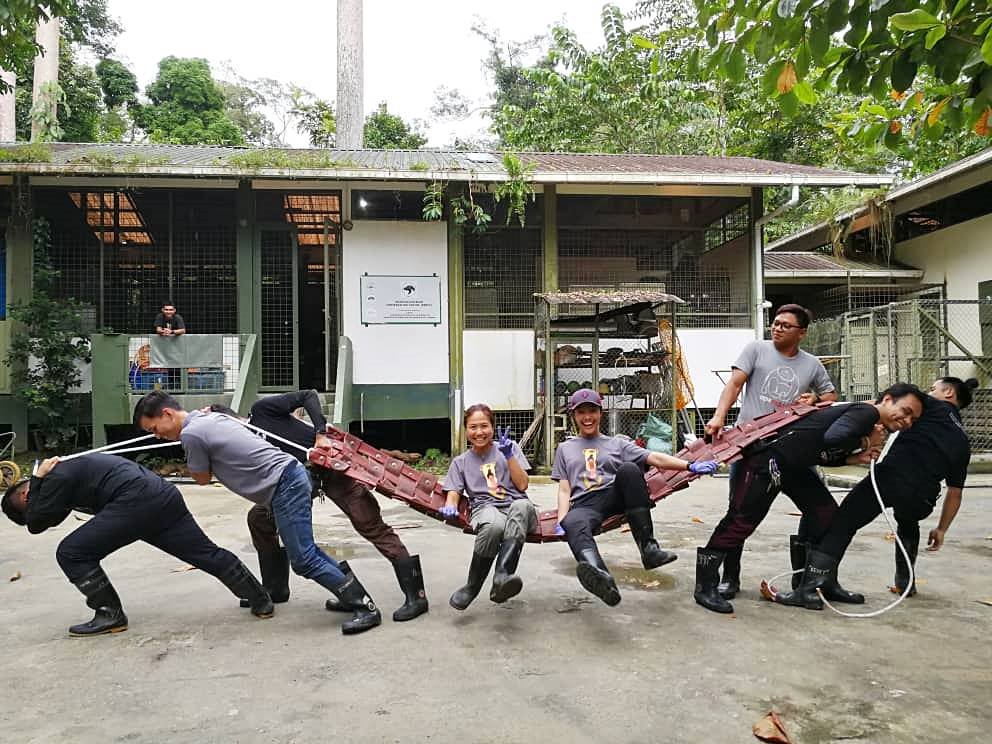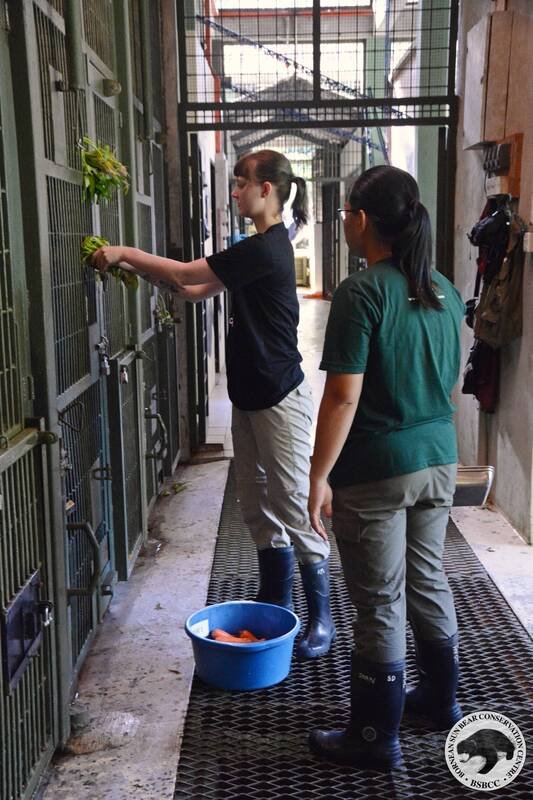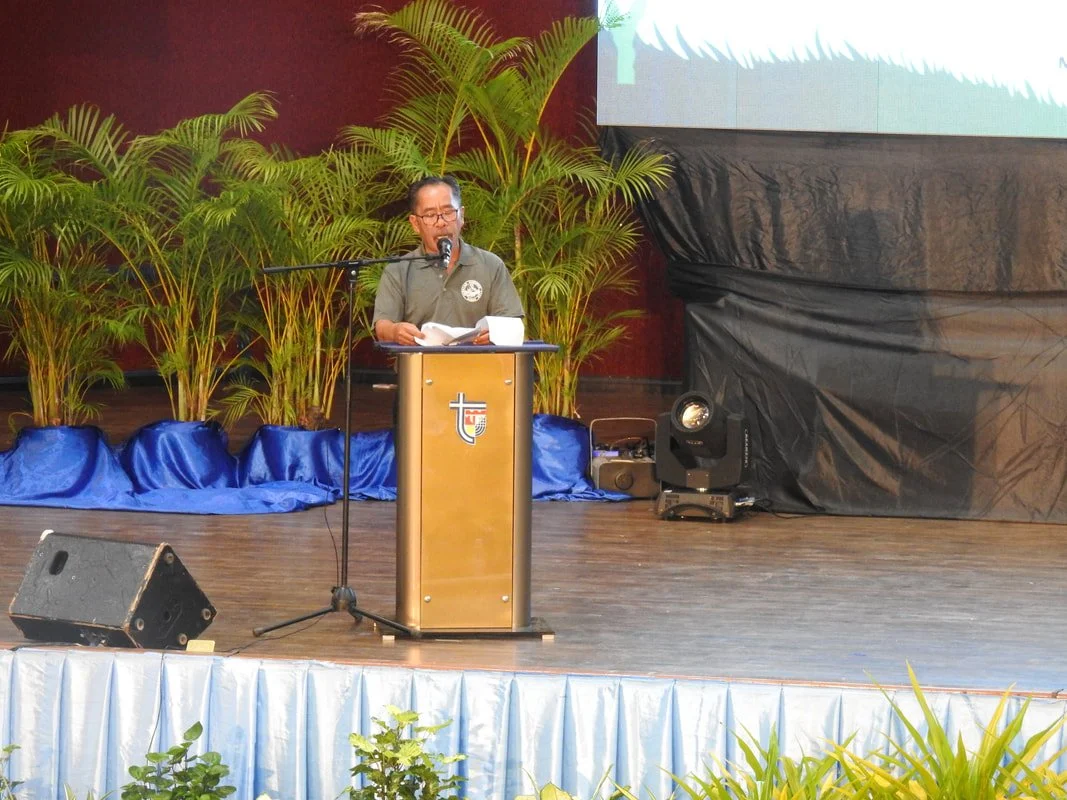BRINGING THE WORLD TO THE BEARS
It all begins with an idea.
Text by Mae Elliessa Shaifubahrim
Photos by Mae Elliessa Shaifubahrim & Chiew Lin May
My first experience volunteering at a conversation centre
Prior to joining the volunteer program at the Borneo Sun Bear Conservation Centre (BSBCC), I had little affiliation or experience with wildlife or the conservation industry. I signed up to volunteer at BSBCC for two weeks to learn about a species endemic to my homeland. In these two weeks I discovered a lot about the sun bears (Helarctos malayanus euryspilus) but the thick of my takeaway from this experience was becoming aware of the importance of the work they are doing at the centre, not just for the bears but especially for the bigger cause of conservation and ecosystem/world/livelihood balance.
Adrian (keeper), Tindra (volunteer), me, Jeniur (keeper and my assigned Buddy) carrying a log to be placed in one of the enclosure for the bears. While the rest of us manage a smile for the camera, Adrian expresses our true sentiments in the hour of extracting this piece of log.
A day in the routine of a bear keeper
Volunteers are gently integrated into the routine of an extensive list of tasks conducted daily to observe the bear house upkeep and care for the bears’ wellbeing- both physical and mental. The keepers do a lot- food prep, cleaning, feeding, enrichment contraptions, building pens etc. to care for forty-three bears is no small feat.
Some may argue they bear (pun intended) resemblance to dogs (uhm. how?) but the upkeep of a bear is incomparable to any domestic house pet (they are wild after all, hello?). Photgraphed are bears Rungus, Fulung, and Montom.
My favourite task would be food prep: preparing a wide (and very very large) assortment of food for the bears’ daily intake. Nothing like a store filled with kilos upon kilos of food washed, cut, weighed, some cooked, and assorted for to-be very happy bears. The next morning we sweep and clean the same weight in poop. There is nothing like it.
I have the utmost admiration and respect for the eight keepers at BSBCC. Seemingly shy and reserved at first, they turned out to be quite a cheeky bunch. The keepers conduct their work with much integrity and were a joy and pleasure to get to know, learn from, and to work with.
Aiman (intern), Bith, Pradeep, Mizuno, Adrian and Danny (keepers) demonstrate their brute strength (wowowow) as Eileen (volunteer) and I test the hammock we just built for the bears. The hammock was made from recycled fire hose donated by the fire department. They bear-ly (heh) made the picture.
Getting to know the bears
In my time at BSBCC I learned to identify a few individual bears by their appearance and behaviour. Each bear have their own particular black spotted-yellow chest mark. I found myself quite drawn to Simone who spends much of her day sitting on top of her water container to observe keepers and passersby as they go about their business. I was often entranced by what her thoughts could be like as I observed her, and she observed me.
Björn Halla // People
For the duration that I was volunteering, I lodged at “Björn Halla” (translated from Swedish to mean “Bear Cave”). A very modest keep that houses some of the staff of BSBCC. It is in this house that I got to know better and was taken by the varied personalities of the people of BSBCC. I witnessed the meticulous care and regard BSBCC in-house vet, Boon takes toward animals. There was one night Dr. Wong (founder of BSBCC) arrived at the house with a nest of two baby squirrels that had been blown away by the night’s heavy rain. I was low-key jumping in my seat at the novelty of the situation while everyone else seemed to behave as if it were absolutely normal. So chill.
I sat with Pradeep at the dining table for enlightening conversations in regards to conservation, wildlife, and even his house cats. The rest of the house are a varied collection of lovely personalities and goofs Yen Wah, Rebecca, Andy, Mizuno, and Jeniur. With housemates like these I hardly had a dull moment in the house. I highly recommend staying with at the staff house if it is available- it is one of the facets of this trip that enriched my experience here even more so.
Saving Sun Bears
It all begins with an idea.
Text by Astrid Mofjell
Photos by Chiew Lin May
My name is Astrid Mofjell, I am 21 years old and I’m from Sweden. I’ve always had an interest in nature and wildlife. The last couple of years I have read so much about animals going extinct, animals in captivity etc. I really wanted to help but did not know how. After spending two weeks working at the BSBCC (Bornean Sun Bear Conservation Center), I really feel like I have made a change. I have had the privilege to help sun bears adapt to a better life and I really recommend more people come here and help the sun bears.
All the volunteers are staying at an accommodation called Paganakan Dii. It is really beautiful there and you have the opportunity to cook your own food if you want to. If you are quite lazy like me, you can buy food at the cafeteria. The food is really good, and you get a lot of food for a cheap price.
At 7:30 in the morning we leave the accommodation to go to the BSBCC and we start to work
At 8:00 in the morning you either work in the kitchen preparing all the food for the bears or in one of the bear houses cleaning cages. When all the food is prepared and the cages are clean, we help to feed the bears too.
At 12:00 p.m. we have a lunch break for one and a half hours. After you have eaten your lunch you have a lot of time to go and look at the sun bears from the platforms if you want to. Here you can watch the bears play, eat, rest and even climb trees.
I think the funniest part of the day is after lunch because then it is time for enrichment. Then we get to be more creative which is very fun. Enrichment is a process which aims to encourage the bears natural behaviour. Most often we create toys with food hidden inside so the bears really have to make an effort to get to the food.
We will finish work at 5:00 p.m.
Working alongside the staff here has taught me so much about sun bears and also a lot about myself. If I had the opportunity to stay for a longer period of time I would. The staff here are really nice and they always make sure that you feel safe. We have shared so much laughter and the mood is always good here. The staff are really kind and they are happy to answer any questions you have.
Each bear has a different story about how they ended up at the BSBCC. Almost every one of them have been kept illegally as a pet. Their stories really touched me and it made me realize how important the work they do here really is. Even though their stories are really sad, it was really nice to see the progress of the work they have done here.
It made me so happy when the staff told me that this May, four of the bears at the center are going to be released into the wild again. I am so inspired by the people working here, the things they do really works and hopefully even more bears can be released soon.
It feels really good to be a part of the solution and I will remember this for the rest of my life.
5 Swedes in Borneo
It all begins with an idea.
Text by Ludwig Gassner
Photos by Ludwig Gassner, APE Malaysia & Chiew Lin May
Hi! This is my short story about my trip and work at the Bornean Sun Bear Conservation Centre (BSBCC). I am Ludwig Gassner and I´m 18 years old. I live in Sweden and I am currently in my last year of studying to become an animal caretaker. When the opportunity arose that I could have an internship here in Borneo I could not turn it down. This was supposed to be an experience of a lifetime and it really was. We have been through and learnt so much, so I do not even know where to begin.
We are 5 volunteers that came here from Sweden. We are all in the same class at school, so we were good friends even from the beginning. We all flew here together, and the flight was very long because we are from Sweden so it took about 24 hours to get here. I believe that was the longest any of us had ever flown before. But eventually we got here, and we were, as most of the volunteers here, staying at Paganakan dii. Our first day when we got here, we got to rest. It was much needed after the jetlag and the long trip. The next day we got to follow our two volunteer coordinators and they helped us to get a small introduction of the BSBCC and all the staff. They helped us to get settled and went grocery shopping with us. The first week of working you really had a lot to take in. All the routines, names of the bears and staff was a great deal of information to memorize and remember. We all got our own keeper and mine was Adneen. He was the one that was going to keep an extra eye on me and to give me different tasks that we needed to do.
The Tiny, Nano
It all begins with an idea.
It all begins with an idea. Maybe you want to launch a business. Maybe you want to turn a hobby into something more. Or maybe you have a creative project to share with the world. Whatever it is, the way you tell your story online can make all the difference.
Don’t worry about sounding professional. Sound like you. There are over 1.5 billion websites out there, but your story is what’s going to separate this one from the rest. If you read the words back and don’t hear your own voice in your head, that’s a good sign you still have more work to do.
Be clear, be confident and don’t overthink it. The beauty of your story is that it’s going to continue to evolve and your site can evolve with it. Your goal should be to make it feel right for right now. Later will take care of itself. It always does.
Do it for The Bears
Text by Tindra Spennare Jacobssen
Photos by Tindra Spennare Jacobssen & APE Malaysia
Hello! My name is Tindra, I am from Sweden and I am 18 years old.
I study animal care at my school Spånga gymnasium and will graduate in a few months. Four of my classmates and myself got the opportunity to be volunteers at the Bornean Sun Bear Conservation Centre thanks to our school. We have now been here for five weeks as a part of our internship.
Photo by Joan
Before I knew about our school’s internship abroad, I had honestly never heard about Sun bears or even the island Borneo, but I have always been interested in conservation and rehabilitation of wild animals, so I did not want to miss such an experience.
During these five weeks I have weighed hundreds of kilos of fruits and vegetables, cleaned a lot of cages and gotten sweaty like never before. We have been going on trips to find banana leaves where we also got to try fresh coconut juice. We went on a walk into the jungle to find termite nests and got attacked by leeches.
I’d rather work than be on holiday
Text by Josefin S.
Photos by Sumira Muis & Chiew Lin May
Hi my name is Josefin. I am from Sweden and I am a student at Spånga gymnasium (a Swedish high school). My four classmates and I have been volunteering at BSBCC (Bornean Sun Bear Conservation Centre) for 5 weeks from 7 January to 7 February. During that time I have learnt and experienced a lot. I have seen a great variety of animals like macaque and different species of bird. I have even been chased by an orangutan. When we came here, we had spent 18 hours in the air and 24 hours travelling with little to no sleep. The temperature went from minus 2 to 30 plus degrees, so on the first day I started to sweat by the thought of moving.
Photo by Sumira
In my first week I spent three days in the kitchen chopping up and weighing different vegetables and fruits. Every bear gets approximately 4.5 kilograms of food each day. As of now the centre is keeping and rehabilitating 43 bears, so you can imagine the amount of food we prepared in one day. During my time here I have improved on a lot of skills. One being cutting up large quantities of fruits with a big knife. I have also learnt how to use different power tools like a drill machine. To engage the bears and encourage their natural behaviour we built enrichments. For example, making a platform that will make it easier and help them learn to climb, because in the wild they spend a lot of time in the trees, sleeping and hiding from predators. Building the enrichment often involved cutting, sawing, drilling, and some sweat and tears. I can assure you that if you volunteer here, at the end of the day you will feel exhausted but very fulfilled. My buddy and I managed to make two different types of enrichment. The first was a piece of wood about 25cm long that we drilled holes into. In the holes we put dog biscuits, mealworms, honey or peanut butter. In total we made 40 pieces, one for each bear. I was so glad when Om (one of the bears) ripped his piece of wood into a million pieces trying to get to the food, it was exactly what I was hoping for
A New Dawn for Sun Bears
Text: Our Better World
A sanctuary and refuge for rescued orphans to grow up wild, the Bornean Sun Bear Conservation Centre has big hopes for the world’s smallest bear.
ONE SUNNY DAY
In a tropical rainforest in Borneo, bear keeper Jeniur “Boboy” Justin is standing on a watching platform 20m above the dense forest floor. He is observing Logan, a young male sun bear who’s busy trying to crack open a coconut. Logan’s claws and powerful jaw make short work of the tough shell, and after a refreshing drink, Logan lays on his back for an afternoon siesta.
“Logan loves to eat, he will steal other bears’ food. He has become chubby, ” says Boboy with a laugh.
Logan and his keeper, Boboy are in the forested area of the Bornean Sun Bear Conservation Centre (BSBCC) in Sandakan, a district in Sabah, East Malaysia. The only centre in the world solely dedicated to the conservation of the sun bear. This has been a refuge for Logan since he was rescued in 2018 as a young cub.
“When Logan first arrived, I could see that he was scared. We found that his left paw had a problem. It got injured in a poacher’s snare,” says Boboy.
Being a young cub without his mother, and with an injured paw, Logan was in need of critical care, and it was Boboy who took on the responsibility of looking after him.
“It’s not easy being a surrogate to Logan,” Boboy reflects. “There are a lot of things we need to know, like how bears, especially babies, can survive in the jungle, how we should teach them to be wild.”
It took months of dedicated care from Boboy for Logan to become confident and capable of fending for himself.
Photo from BSBCC
A DARK CLOUD
Logan’s plight is far from an isolated incident. Since BSBCC was set up in 2008, the centre has worked with the state wildlife department, to rescue over 60 bears.
“On average, we have five to six bears being sent to our centre every year; half of them are adults and half of them are cubs. All of these animals are all orphaned, because their mums were killed by poachers,” laments Dr Wong Siew Te (who goes by Wong), founder of the BSBCC.
Sun bears, which are the world’s smallest bear and found all across Southeast Asia, are listed as Vulnerable on the IUCN Red List. Though the exact numbers of sun bears remains unverified, studies have shown that their population has fallen by over 30 per cent in the last three decades.
Habitat loss has been a major factor in this, but the biggest threat that the bears currently face is from poaching for industries like the pet trade and food. Despite being a legally protected species in Malaysia, poaching activities still persist.
One of the biggest current threats, comes from their use in traditional Chinese medicine (TCM). For centuries, bear bile and gall bladders have been sought after for treating a variety of ailments. A recent report by TRAFFIC, stated that almost 70 per cent of all TCM shops in Malaysia were found with some form of bear products. Up from 2012, when it was at 48 per cent.
Photo from TRAFFIC
But while the use of bear products in TCM has increased, so has knowledge of TCM over the years. There is now a realisation that there are viable and healthy alternatives to using wildlife products. The Federation of Chinese Physicians and Medicine Dealers Association of Malaysia, is advocating for the use of medical herbs instead.
“We can completely use medicinal herbs to replace animals” states Ng Kean Hwa, a second-generation TCM practitioner. “With a clear diagnosis, and when used appropriately, it can directly help achieve the curative effect and is a good form of protection towards the natural environment.”
The value of looking after sun bears and not exploiting them isn’t just for the benefit of the bears. Sun bears provide a very tangible benefit to the welfare of people as well.
Sun bears help maintain a healthy diversity of trees by keeping termite populations in check, and dispersing seeds. These trees are essential resources that people use for medicine, building infrastructure, and other needs that are important to the well-being of society.
“For us as humans, we need a healthy forest ecosystem to provide us with clean air, clean water, stable climate, genetic resources like medicine. All of these matter to us,” says Wong.
To help educate the public on the need to conserve sun bears, Wong has opened the centre for the public to view the bears in a forested enclosure, and to raise public awareness about their plight through education and eco-tourism.
Here, the bears are fed their natural diet and have regular medical and dental check-ups. Rehabilitation is a critical component of BSBCC’s work, and when the bears are suitable for release, they are returned to the wild. To date, BSBCC has successfully released seven sun bears into protected forests.
“My hope for all sun bears is that they can survive for a long, long time in Southeast Asia,” declares Wong. “I really hope that the sun bears can live forever in this world.”
RAYS OF HOPE
Back at the platform, Logan has woken from his nap and is climbing a tree in search of something else to eat. Boboy smiles as any proud parent would, and shares a story of when he had to teach Logan the art of tree-climbing.
“There was one time I climbed a small tree, and the tree wasn’t able to support me, and the branch almost broke. What I was most afraid of was that Logan was just below me, and I feared I would be crushed along with Logan,” he shares with a laugh.
“Logan’s hand was weak when it came to climbing trees, but he still challenged himself and refused to give up. That’s why I like Logan. I have spent all this time working with him and our relationship is so close.”
Today, Logan is a master tree climber, despite having a deformed paw. But Boboy has bigger hopes for his "adopted" bear. “In time, we will try our best to fix Logan’s paw… so he can be like other bears, and be released into the wild.”
The desire for the sun bears to see a new dawn, is one that Boboy wishes all Malaysians will come to embrace. “I hope that everyone can work together to protect and care for the wild animals we have. I hope that one day, my children will have the opportunity to see the sun bear in the wild.”
Before he returns to look after the rest of the bears under his care, Boboy has one last story to share. “We gave him the name Logan because of his left paw. It looks like the comic superhero Wolverine’s claw,” says Boboy with a smile.
High up in the trees, Logan has found a comfortable spot, and like a true hero, has fallen asleep once again.
LET’S TALK ABOUT IT:
How can we get more involved in sun bear conservation and spread awareness?
ABOUT BORNEAN SUN BEAR CONSERVATION CENTREEstablished in 2008 by wildlife biologist Dr Wong Siew Te, the Bornean Sun Bear Conservation Centre (BSBCC) is the world’s only conservation and research centre solely dedicated to the rescue and rehabilitation of the Malayan sun bear. A sanctuary for bears to recuperate and relearn natural behaviour for release back into the wild, the centre also aims to spread public awareness through eco-tourism and education.
CONTRIBUTORSDirector & Editor
Chris Annadorai
Producer & Writer
Lilian Tan
Camera
Shawn Khoong
World Wildlife Day @ Tawau (4-5 March 2020)
On the 4-5th of March 2020, BSBCC attended the annual World Wildlife Day 2020 organized by Sabah Wildlife Department at the Tawau Community Hall, Tawau, Sabah. Lots of NGOs and State Departments invited to the event, aiming for the primary and secondary schools students and also the public. The two-day event filled with lots of activities such as informative talks, choral speaking competitions, and lots of booth opened by the attending NGOs and departments. The event was officiated by Permanent Secretary of the Ministry of Tourism, Culture and Environment, Dr. Jamili Nais. Also attending the event is the Director of Sabah Wildlife Department, Augustine Tuuga. Big thanks to Sabah Wildlife Department for invited us to this big and important event.
World Wildlife Day @ Tawau
On the 4-5th of March 2020, BSBCC attended the annual World Wildlife Day 2020 organized by Sabah Wildlife Department at the Tawau Community Hall, Tawau, Sabah. Lots of NGOs and State Departments invited to the event, aiming for the primary and secondary schools students and also the public. The two-day event filled with lots of activities such as informative talks, choral speaking competitions, and lots of booth opened by the attending NGOs and departments.
The event was officiated by Permanent Secretary of the Ministry of Tourism, Culture and Environment, Dr. Jamili Nais. Also attending the event is the Director of Sabah Wildlife Department, Augustine Tuuga.
Big thanks to Sabah Wildlife Department for invited us to this big and important event.
Tree Loving: Romolina
Video by Chiew Lin May
"Basindo nan tenggil"
Did you know the Malay name for the sun bear means “he who likes to sit high"?











































































































































































































